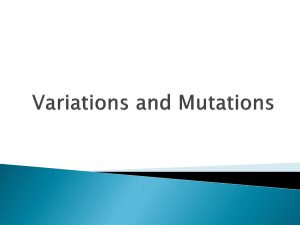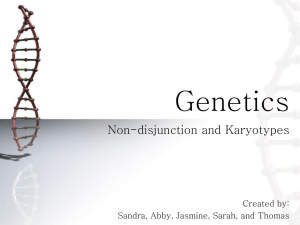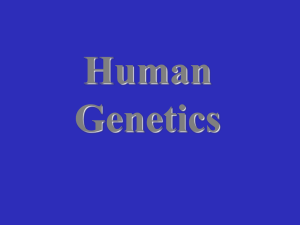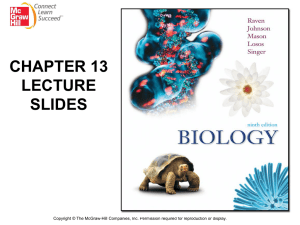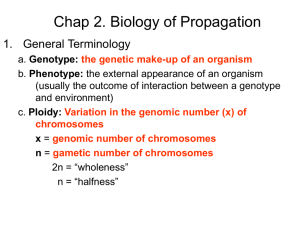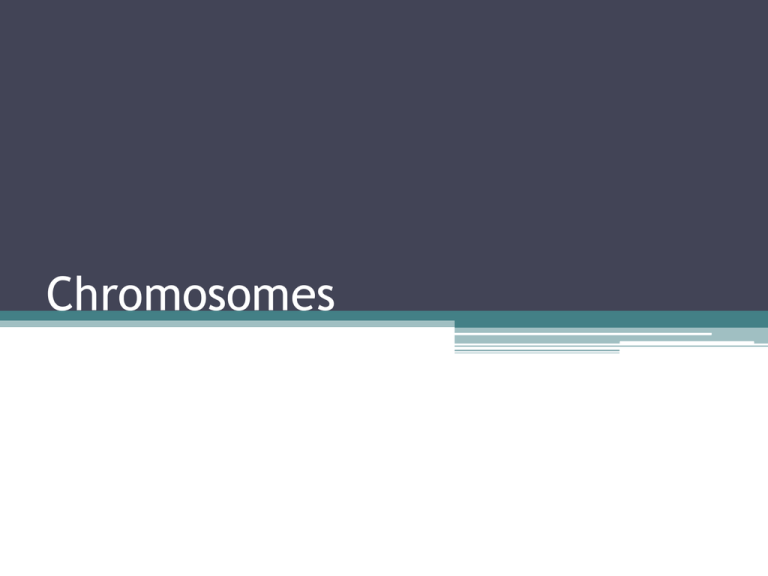
Chromosomes
Chromosome
• Tightly coiled DNA form
• Found during mitosis and
meiosis
• Made mostly of DNA and
proteins
• Centromere- point of
attachment
• Chromatids- each arm of a
chromosome in replicated
form
• Banding
▫ Heterochromatin- dark area
with repetitive sequences
▫ Euchromatin- lighter proteinencoding area
Chromosome Structure: Telomeres
• Chromosomal tips
• Human
chromosomes
have repeats of
TTAGGG
• Telomeres shorten
during each cell
division in most
cells
Chromosome Structure: Centromere
• Constricted region of
chromosome
• Region of attachment of spindle
fibers during mitosis and
meiosis
• Contains many repeats of a 171base sequence called the alpha
satellite
• Centromere associated proteins
▫ Some form kinetochore during
mitosis and meiosis
▫ Centromere protein A (CENPA)- surround centromere; are
divided and continue with each
chromatid during anaphase
Chromosome Structure
• Moving away from the centromere
▫ Gene-rich regions
▫ Subtelomeres
Gene start to taper off
More repeats start to occur
Chromosome Shorthand
• Shorthand used to locate gene
on chromosome
• First number is chromosome
number
• Letter (p or q) refers to the
arm
• Second number refers to the
band on that arm
▫ Number gets higher as the
band is farther from the
centromere
Chromosomal Differences
• Size Difference
▫ Chromosomes are numbered from 1 (largest)-22
(smallest)
• Banding differences
• # of Genes
▫ Some chromosome have very few genes for their
size, and some have a lot of genes for their size
• Location of Centromere
Location of the Centromere
• Metacentric- located in the
middle; divides chromosomes
into two equal arms
• Submetacentric- located
slightly off of center; divides
the chromosome into a long
(q) arm and a short (p) arm
• Acrocentric- located near one
end of the chromosome;
divides the chromosome into a
long (q) arm and a chort (p)
arm
• Telocentric- located at the end;
humans do not have these
Karyotype
• Pictorial representation of
chromosomes
• Autosomal chromosomes are
lined up by number (from
largest to smallest)
• Sex Chromosomes are
arranged last
• What does it tell you?
▫ Sex of individual
▫ Presence of chromosomal
abnormality
Obtaining a Sample
• Blood sample or cheek cell
sample
• Embryo
▫
▫
▫
▫
Amniocentesis
Chorionic Villus Sampling
Fetal Cell Sorting
Pre-implantation Testing
Creating a Karyotype
• Cell division is stopped with colchicine
• Cell is ruptured
• Cell with the most spread out chromosomes is
used
• Chromosomes are identified with stain or FISH
▫ Staining- use chromosome specific stains
▫ FISH (fluorescence in situ hybridization)fluorescent probes are attached to chromosomes;
each chromosome fluoresces a different color
Karyotype Analysis Shorthand
• 46,XX
• First number- number of
chromosomes
• Sex chromosomes
• Extra information
▫ Extra chromosomes (+#)
Chromosomal Abnormality: Polyploidy
• Extra set of chromosomes
• Triploid (3 sets)
▫ Ovum is fertilized with two
sperm
▫ One gamete remains diploid
after meiosis
• Usually spontaneous abortion
Chromosomal Abnormailty: Aneuploidy
• Have a missing or extra
chromosome
• Most are spontaneously
aborted
• Some types can survive until
birth
• Monosomy- missing one
chromosome
▫ Only one viable is XO (Turner
Syndrome)
• Trisomy- extra chromosome
Nondisjunction
• Most aneuploidy results from
nondisjunction
• Chromosomes fail to separate
during meiosis
• More commonly seen in
females (especially with older
maternal age)
• Results in some gametes
missing chromosomes and
some having extra
Mosaics
• Aneuploidy occurs during
mitosis
• Individual has some cells
that are normal and some
that are aneuploid
• Severity of disorder
depends on when during
development that it
happens
Common Aneuploids
• Autosomal
▫ 47, X__ +21– Down Syndrome
▫ 47, X__ +13- Patau Syndrome
▫ 47, X__ +18- Edward Syndrome
• Sex Chromosome
▫
▫
▫
▫
45, XO- Turner Syndrome
47, XXX- triplo-X
47, XXY- Klinefelter’s Syndrome
47,XYY- Jacobs Syndrome
Chromosomal Alterations
• Structural problems of chromosomes
• Include
▫
▫
▫
▫
Deletions
Duplications
Translocations
Inversions
Deletions
• Deletion of part of a
chromosome
• The larger the deletion, the
more severe the disorder
• Microdeletions- small
deletions that can create
symptoms (ex: impair fertility
if on Y chromosome)
• Cri-du-chat- deletion of part of
the short arm of chromosome
5 (5p-)
Duplication
• Chromosome with
repeated sections
• Usually repeats have to
be large to be
symptomatic
• Fragile X syndromeexpanding triplet repeat
adds extra material to X
Translocations
• Two nonhomologous chromosomes exchange or
combine parts
• Robertsonian translocation- short arms are removed
from two chromosomes; long arms stick together to form
one long chromsome
▫ Problems for future generations
• Reciprocal translocation- two different chromosomes
exchange parts
▫ Problem for individual if gene is broken
▫ Problem for future generations
• Translocation carrier- asymptomatic carrier of
translocation
Robertsonian Translocation
Reciprocal Translocation
Inversion
• Chromosome with some genes inverted
• Paracentric inversion▫ Does not include centromere
▫ Crossing over can result in
Normal chromosomes
Dicentric chromosome (two centromeres)
Acentric chromosome (no centromere)
• Pericentric inversion▫
▫
▫
▫
Does include centromere
Crossing over can result in
Normal chromosomes
Abnormal chromosomes with one centromere
Inversion
Isochromosomes and Ring
Chromosomes
• Isochromosome
▫ Chromosome splits the
wrong way during
meiosis
▫ Chromosome end up with
identical arms
• Ring Chromosome
▫ Removal of telomeres
creates sticky end
▫ Sticky ends attach to each
other creating a ring
Uniparental Disomy
• Individual has a chromosome set where both
chromosomes come from one parent
• Can cause problems with recessive alleles or
imprinting
• Occurs if
▫ One parent has nondisjunction resulting in a
gamete with that chromosome missing
▫ One parent has nondisjunction resulting in a
gamete with both homologs of that chromosome
▫ These two fertilize each other



